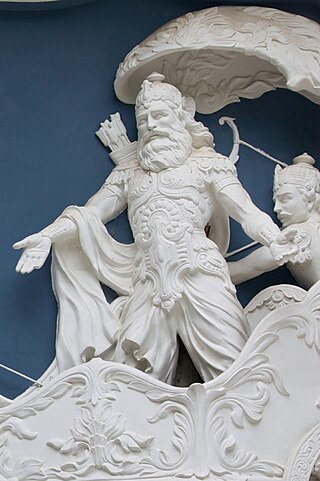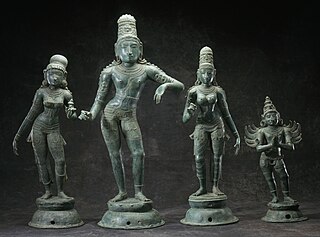
Indian religions, sometimes also termed Dharmic religions or Indic religions, are the religions that originated in the Indian subcontinent. These religions, which include Hinduism, Jainism, Buddhism, and Sikhism, are also classified as Eastern religions. Although Indian religions are connected through the history of India, they constitute a wide range of religious communities, and are not confined to the Indian subcontinent.

Kshatriya is one of the four varnas of Hindu society and is associated with the warrior aristocracy. The Sanskrit term kṣatriyaḥ is used in the context of later Vedic society wherein members were organised into four classes: brahmin, kshatriya, vaishya, and shudra.

The historical Vedic religion, also known as Vedicism and Vedism, constituted the religious ideas and practices prevalent amongst the Indo-Aryan peoples of the northwest Indian subcontinent during the Vedic period. These ideas and practices are found in the Vedic texts, and some Vedic rituals are still practiced today. The Vedic religion is one of the major traditions which shaped Hinduism, though present-day Hinduism is significantly different from the historical Vedic religion.
Shudra or Shoodra is the one of the four varnas of the Hindu varna system and social order in ancient India. Some sources translate it into English as a caste, or alternatively as a social class. Theoretically, Shudras constituted a class like employees.

Magadha also called the Kingdom of Magadha or the Magadha Empire, was a kingdom and empire, and one of the sixteen Mahajanapadas, 'Great Kingdoms' of the Second Urbanization, based in southern Bihar in the eastern Ganges Plain, in Ancient India. Magadha was ruled by the Brihadratha dynasty, the Haryanka dynasty, the Shaishunaga dynasty, the Nanda dynasty, the Mauryan dynasty, the Shunga dynasty and the Kanva dynasty. It lost much of it territories after being defeated by the Satavahanas of Deccan in 28 BC and was reduced to a small principality around Pataliputra. Under the Mauryas, Magadha became a pan-Indian empire, covering large swaths of the Indian subcontinent and Afghanistan.

The Nanda dynasty was the fifth ruling dynasty of Magadha in northern Indian subcontinent during the fourth century BCE and possibly also during the fifth century BCE. The Nandas overthrew the Shaishunaga dynasty, and expanded the empire to include a larger part of northern India. Ancient sources differ considerably regarding the names of the Nanda kings and the duration of their rule, but based on the Buddhist tradition recorded in the Mahāvaṃsa, they appear to have ruled during c. 345–322 BCE, although some theories date the start of their rule to fifth century BCE.

Kosala, sometimes referred as "Uttara Kosala" transl. "Northern Kosala") was one of the sixteen great realms of ancient India. It emerged as a small state during the Late Vedic period and became one of the earliest states to transition from a lineage-based society to a monarchy. By the 6th century BCE, it had consolidated into one of the four great powers of ancient northern India, along with Magadha, Vatsa, and Avanti.

Āryāvarta is a term for the northern Indian subcontinent in the ancient Hindu texts such as Dharmashastras and Sutras, referring to the areas of the Indo-Gangetic Plain and surrounding regions settled by Indo-Aryan tribes and where Indo-Aryan religion and rituals predominated. The limits of Āryāvarta extended over time, as reflected in the various sources, as the influence of the Brahmanical ideology spread eastwards in post-Vedic times.

The Mahājanapadas were sixteen kingdoms or oligarchic republics that existed in ancient India from the sixth to fourth centuries BCE, during the second urbanisation period.

The history of Hinduism covers a wide variety of related religious traditions native to the Indian subcontinent. It overlaps or coincides with the development of religion in the Indian subcontinent since the Iron Age, with some of its traditions tracing back to prehistoric religions such as those of the Bronze Age Indus Valley Civilisation. Hinduism has thus been called the "oldest religion" in the world. Scholars regard Hinduism as a synthesis of various Indian cultures and traditions, with diverse roots and no single founder. This Hindu synthesis emerged after the Vedic period, between c. 500 and 200 BCE and c. 300 CE, in or after the period of the Second Urbanisation, and during the early classical period of Hinduism. It flourished in the medieval period, with the decline of Buddhism in India.

A chakravarti is an ideal universal ruler, in the history, religion, and mythologies of India. The concept is present in Indian subcontinent cultural traditions, narrative myths and lore. There are three types of chakravarti: chakravala chakravarti, an emperor who rules over all four of the continents ; dvipa chakravarti, a ruler who governs only one of those continents; and pradesha chakravarti, a monarch who leads the people of only a part of a continent, the equivalent of a local king. Dvipa chakravarti is particularly one who rules the entire Indian subcontinent. The first references to a Chakravala Chakravartin appear in monuments from the time of the early Maurya Empire, in the 4th to 3rd century BCE, in reference to Chandragupta Maurya and his grandson Ashoka.

A śramaṇa or samaṇa is a person "who labours, toils, or exerts themselves for some higher or religious purpose" or "seeker, one who performs acts of austerity, ascetic". During its development, the term came to refer to several non-Brahmanical ascetic religious movements parallel to but separate from the Vedic religion's. The Śramaṇa tradition includes primarily Jainism, Buddhism, and others such as the Ājīvika.

Kuru was a Vedic Indo-Aryan tribal union in northern Iron Age India, encompassing parts of the modern-day states of Haryana, Delhi, and some parts of western Uttar Pradesh, which appeared in the Middle Vedic period. The Kuru Kingdom was the first recorded state-level society in the Indian subcontinent.

Videha was an ancient Indo-Aryan tribe of north-eastern Indian subcontinent whose existence is attested during the Iron Age. The population of Videha, the Vaidehas, were initially organised into a monarchy but later became a gaṇasaṅgha, presently referred to as the Videha Republic, which was part of the larger Vajjika League.
The region have been inhabited since the Stone Age. Copper tools from the Chalcolithic period have been discovered. This area entered the Iron Age during the mid-2nd millennium BCE.

The Vedic period, or the Vedic age, is the period in the late Bronze Age and early Iron Age of the history of India when the Vedic literature, including the Vedas, was composed in the northern Indian subcontinent, between the end of the urban Indus Valley Civilisation and a second urbanisation, which began in the central Indo-Gangetic Plain c. 600 BCE. The Vedas are liturgical texts which formed the basis of the influential Brahmanical ideology, which developed in the Kuru Kingdom, a tribal union of several Indo-Aryan tribes. The Vedas contain details of life during this period that have been interpreted to be historical and constitute the primary sources for understanding the period. These documents, alongside the corresponding archaeological record, allow for the evolution of the Indo-Aryan and Vedic culture to be traced and inferred.
Johannes Bronkhorst is a Dutch Orientalist and Indologist, specializing in Buddhist studies and early Buddhism. He is emeritus professor at the University of Lausanne.

The Janapadas were the realms, republics (ganapada) and kingdoms (sāmarājya) of the Vedic period on the Indian subcontinent. The Vedic period reaches from the late Bronze Age into the Iron Age: from about 1500 BCE to the 6th century BCE. With the rise of sixteen Mahajanapadas, most of the states were annexed by more powerful neighbours, although some remained independent.
Vedic learning started in Mithila with the expansion of Vedic and Brahmanic culture eastwards along the Ganges plain. Some sources consider this centre of Brahminical study to form an Ancient Mithila University. From the 12th/13th to 15th century CE it was an important centre of Nyaya Shastra and logical sciences.
Brahminism or Brahmanism is a doctrine developed from the Vedic religion, which incorporates non-Vedic religious religious ideas; and expanding to a region stretching from the northwest Indian subcontinent to the Ganges valley. Originally the doctrine arose out of the concept of Brahman, the ultimate reality, but eventually evolved into the doctrine of Brahminism.













